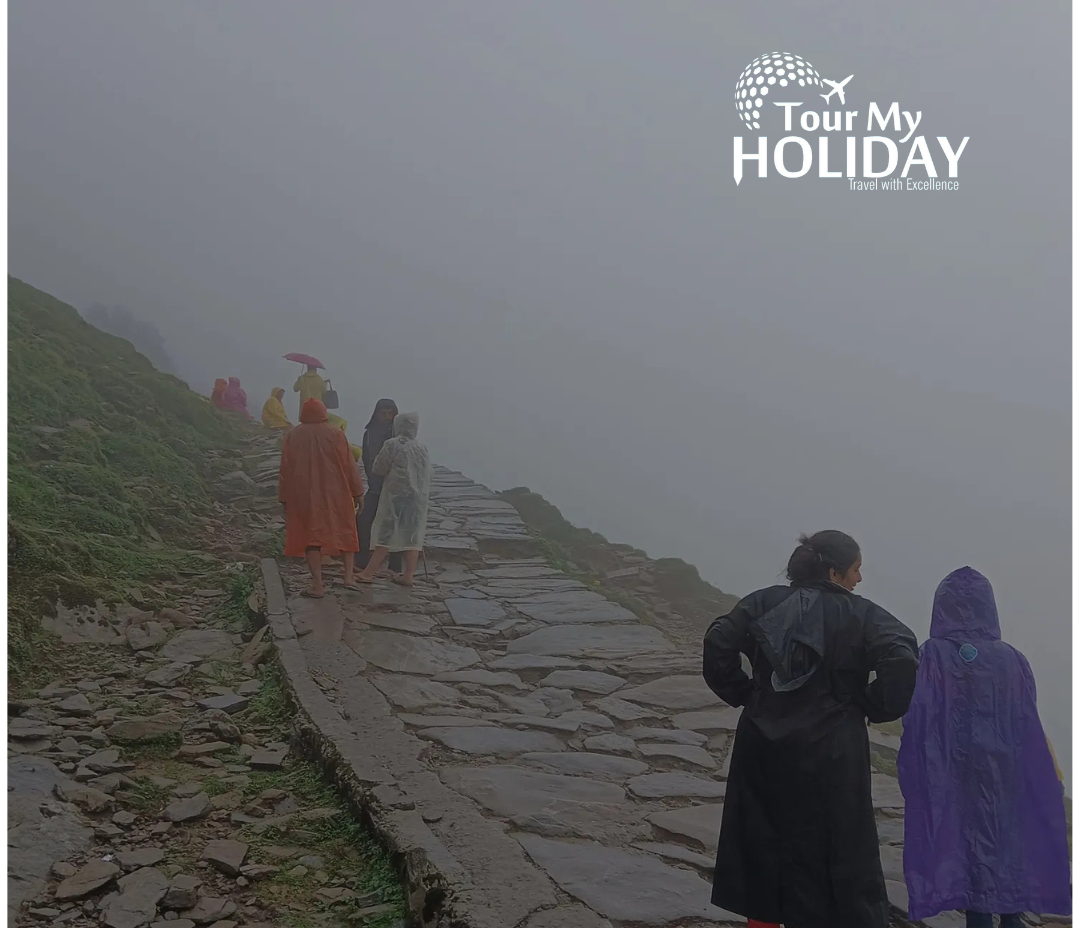Introduction: Monsoon Vibes in Chopta
Tucked away in the heart of Uttarakhand, Chopta transforms into a mystical paradise during the monsoon and the right Chopta tour package can make the experience even more magical. I had always seen pictures of Chopta bathed in golden sunlight or blanketed with snow, but it was during the rainy season that I truly experienced its untouched magic. Mist rolling over lush green meadows, the scent of wet pine, and raindrops dancing on rhododendron leaves ,monsoon in Chopta feels like nature’s poetry in motion.
While most travelers prefer the summer or winter months, I took a leap of faith and booked my trip during July. Honestly, I wasn’t sure what to expect. Would landslides ruin the plan? Would the treks be slippery and dangerous? But the moment I arrived, I knew I had made the right choice. The serene atmosphere, far from the crowd, gave me the kind of peace city life never allows.
What made this journey even smoother was the Chopta tour package I opted for. Instead of stressing over hotel bookings, transport arrangements, and weather updates, everything was taken care of. There are several packages available online these days—some focus on adventure, some on spirituality, and some like mine combine both. Whether you’re a solo traveler, a couple looking for a romantic escape, or a group of friends seeking thrill, there’s something for everyone.
I’ll be sharing every detail from this trip—from the refreshing Tungnath Temple Trek, the dramatic views from Chandrashila summit, to the delicious pahadi food we had at roadside dhabas. And yes, I’ll also break down the Chopta tour package I chose: what it included, how much it cost, and whether it was worth it.
If you’re wondering whether it’s a good idea to visit Chopta during the monsoon, let me help you decide. Through this blog, I’ll share my honest experience so you can plan your own unforgettable escape to the clouds.

Why Monsoon Makes Chopta Extra Magical
The moment we began the Chopta Tungnath Trek, I realized that the monsoon doesn’t just bring rain it brings life. The meadows of Chopta, already beautiful, explode into a riot of green. Ferns unfurl at your feet, wildflowers bloom along the trail, and clouds drift lazily through the forests. The whole region feels like it has just exhaled after a long dry spell, and you get to witness nature at its purest.
Trekking during the monsoon might sound tricky, but trust me, if you’re well-prepared, it’s a surreal experience. The Chopta Tungnath Trek winds through thick deodar and rhododendron forests, and in the rains, every leaf glistens like it’s been polished. The soft squish of mud beneath your boots, the earthy smell of wet wood, and the occasional call of a Himalayan monal—all of it adds to a sensory overload I didn’t expect.
As we made our way higher toward Tungnath Temple , the mist rolled in, wrapping everything in a white hush. Visibility dropped, but strangely, that made the experience even more intimate. The ancient temple, shrouded in fog, looked like a secret whispered by the mountains themselves. The rain had turned the stone paths slick, but every step felt sacred. I couldn’t help but feel I was part of something timeless.
But the real magic awaited above Chandrashila Trek was the crown jewel. Though it’s a bit more challenging in the rain, the reward is unmatched. We started the climb early, catching glimpses of the peaks in between cloud breaks. The higher we went, the more dramatic the scenery became. Imagine standing at 13,000 feet, clouds swirling below, the Garhwal Himalayas rising above, and not a single soul in sight. That’s Chandrashila Trek in the monsoon.
Yes, there were moments of caution—slippery sections, light drizzles turning heavy without warning—but these are part of the story. Monsoon demands respect, but it also rewards those who embrace it. And treks like Chopta Tungnath and Chandrashila become something more than just physical journeys—they become soulful experiences.
If you’re seeking more than just scenic views, if you want to feel the forest breathe and the mountains speak, then the monsoon is your season. And the Chopta Tungnath Trek and Chandrashila Trek will show you why this time of year is truly unforgettable.

Challenges of Visiting Chopta During Rainy Season
While the monsoon paints Chopta in vibrant shades of green, it’s not without its share of challenges. This isn’t the season for casual tourists or luxury seekers—it’s for those willing to embrace unpredictability. My trip taught me that nature’s beauty often comes with a wild side.
The first and most obvious challenge is the weather itself. Rain is constant—sometimes a light drizzle, sometimes an all-out downpour. Roads become slippery, visibility drops, and landslides can occur without warning. We encountered a roadblock just before Rudraprayag that delayed us by two hours. It wasn’t dangerous, but it reminded me how quickly conditions can change in the hills.
The Tungnath temple trek is especially tricky during this time. The 3.5 km trail from Chopta to Tungnath might seem easy on paper, but rain transforms the stone steps into a slippery path. There are no railings or support along much of the way, so each step requires focus and good trekking shoes. Many travelers turn back halfway, but with patience and care, the temple is still very much accessible.
If you plan on attempting the Chandrashila summit after visiting the temple, expect fog, strong winds, and zero visibility at times. We had to wait for the weather to clear before making our final push. It was absolutely worth it—but not everyone may feel comfortable with the uncertainty.
Accommodation can also be basic. During the monsoon, many hotels and camps in Chopta remain closed or operate with limited facilities. Power cuts are common, and internet connectivity is weak to nonexistent. This is where good Chopta tour packages come in handy. Packages often include guides familiar with the terrain, pre-checked accommodations that stay open year-round, and vehicles with experienced hill drivers who know how to navigate wet, narrow roads.
Lastly, it’s important to stay updated on travel advisories. The Uttarakhand government sometimes issues warnings during heavy rainfall periods. Always check before traveling, and inform your family or friends of your route and stay.
Despite the risks, I found the challenges of visiting Chopta in the rainy season to be part of the charm. With the right gear, mindset, and a reliable Chopta tour package, even the obstacles turn into stories you’ll never forget.
The Tungnath Temple Trek in Monsoon
Of all the treks I’ve done, the Tungnath temple trek in monsoon stands out as something beyond just a physical journey. It felt deeply spiritual, not only because of the sacred destination but also due to the surreal atmosphere the rainy season creates. This isn’t just a trek—it’s a walk into the clouds.
We started the Chopta Tungnath Trek early in the morning. The rain had just stopped, and mist floated low across the meadows like it was guiding us. The paved trail starts gently from Chopta and gradually climbs through patches of dense forest and open alpine grasslands. The surroundings were glowing green—like the earth had been freshly painted. Water droplets clung to every leaf, and mountain dogs walked alongside us like silent monks.
There’s something about the monsoon that quiets everything around you. You don’t hear tourists shouting or music playing; instead, it’s the wind through the trees, the crunch of your boots, and the distant ringing of temple bells carried by the breeze. The Tungnath temple trek becomes less of a hike and more of a moving meditation.
The elevation gain isn’t extreme, which makes the Chopta Tungnath Trek doable even in light showers. But yes, caution is key—especially around sharp turns and mossy stones that get slippery. I saw a couple of fellow trekkers slip and thankfully recover without injury, but it was a reminder to respect the terrain. A pair of good trekking shoes and a poncho are absolute essentials.
When we finally reached Tungnath Temple, clouds were curling around the ancient stone structure. It’s the highest Shiva temple in the world, and during the monsoon, it feels like the heavens are literally within reach. We offered prayers in silence while the temple priest, wrapped in wool and rainwear, performed aarti with complete devotion, undeterred by the drizzle.
Many skip this trek during the rainy season, fearing bad weather. But that’s precisely when it feels most divine. The crowds are fewer, the air is pure, and the connection you feel—to nature and something bigger than yourself—is stronger than ever.
If you’re planning to take the Chopta Tungnath Trek, don’t rule out the monsoon. Yes, it’s challenging `but it also offers a kind of beauty and calm you won’t find in any other season. And for those seeking both adventure and spiritual energy, the Tungnath temple trek in monsoon is a sacred gift waiting to be unwrapped.
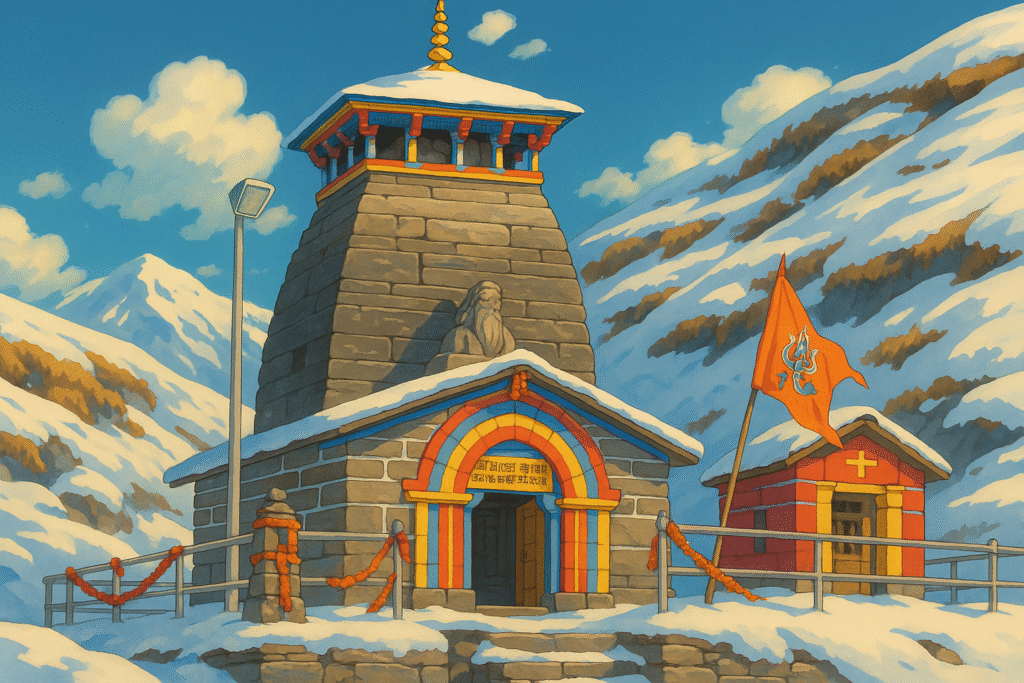
Chandrashila Summit Trek: Worth the Misty Challenge?
If reaching Tungnath Temple felt like stepping into a sacred realm, continuing onward to Chandrashila summit trek felt like venturing into the unknown. The final leg of the Chopta Chandrashila trek begins just behind the temple and climbs about 1.5 kilometers further. It may sound like a short distance, but during the monsoon, it tests your endurance, patience, and trust in the mountain.
We started our Chandrashila summit trek around 6:30 AM, just as the rain paused and a few sun rays tried to peek through the clouds. The trail isn’t well-marked, and loose stones combined with thick mist made it difficult to gauge how far we had left. There were moments when we could barely see 10 feet ahead, and the climb felt more mental than physical. But that quiet—broken only by our own breath and the occasional whistle of wind—made every step feel significant.
Despite the fog, we kept going. The monsoon had turned the path into a moss-covered ribbon winding up the ridge, and we moved slowly, carefully, gripping our trekking poles tightly. When we finally reached the top, visibility was low, but something magical happened. In a matter of seconds, the clouds parted just briefly to reveal towering Himalayan peaks: Nanda Devi, Trishul, Kedarnath, and Chaukhamba. That fleeting view was like a reward from the mountain itself.
The Chopta Chandrashila trek in monsoon isn’t for everyone. It requires good gear, proper guidance, and a flexible mindset. Weather changes fast, and sometimes, you might not even get a summit view. But honestly? Even if we hadn’t seen the peaks, just being up there, feeling the wind whip through the prayer flags and watching clouds swirl beneath our feet, would have been enough.
Many people ask if the Chandrashila summit trek is worth attempting during the rainy season. My answer is yes with preparation. Go with a group or guide, carry rain covers for your gear, and be ready to turn back if the weather worsens. But if the skies grant you even five minutes of clarity, you’ll witness a Himalayan panorama that stays with you for life.
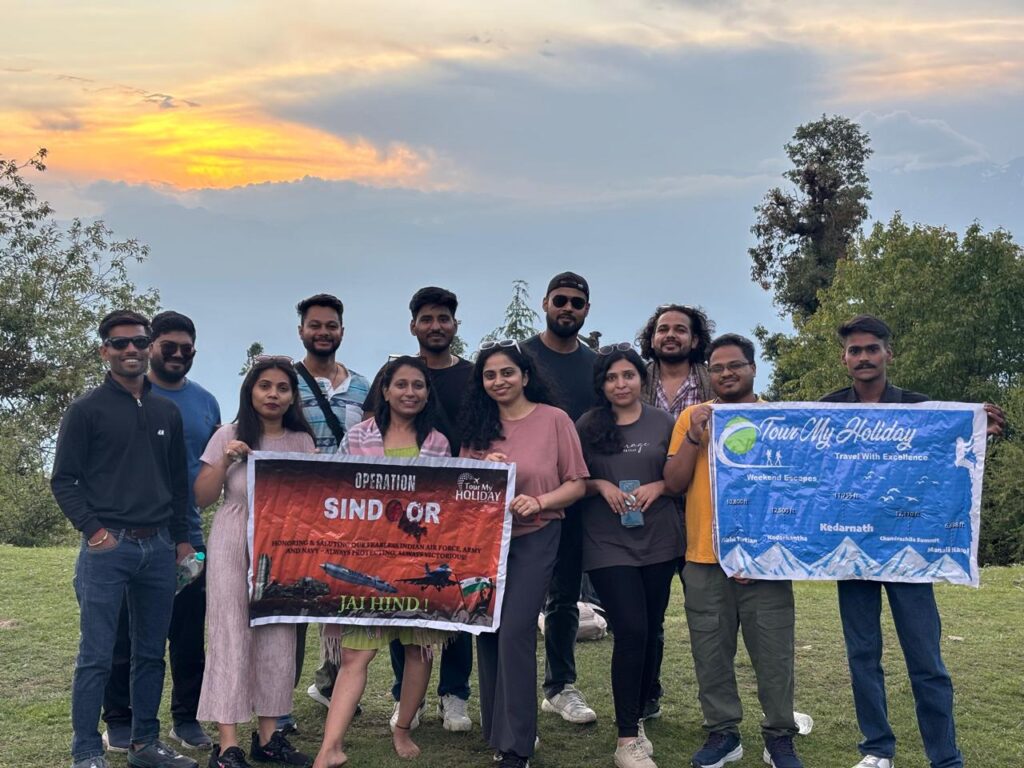
Top 5 Places to Cover in Chopta Tour Package: A Blend of Nature and Spirituality
Chopta is not just a trekker’s paradise—it’s the gateway to some of Uttarakhand’s most spiritual and scenic destinations. If you’re planning a trip, don’t miss these five spots that offer breathtaking views and divine energy. These are often included in the best Chopta tour packages, making your journey even more fulfilling.
Devprayag Sangam
Devprayag is the sacred meeting point of two holy rivers—Alaknanda and Bhagirathi—which merge to form the Ganga. The tranquility of this place is unmatched, making it a must-visit stop for anyone seeking peace and spiritual awakening.
Learn more about Devprayag Sangam
Deoria Tal
Nestled in the lap of the Himalayas, Deoria Tal is a crystal-clear lake that reflects the mighty Chaukhamba peaks. The 2 km trek from Sari village is accessible and ideal for beginners, photographers, and nature lovers. Many Chopta Tungnath trek itineraries include this serene spot.
Explore Deoria Tal in detail
Tungnath & Chandrashila Trek
Tungnath is the highest Shiva temple in the world, and the trek to Chandrashila peak offers panoramic views of the snow-clad Himalayas. It’s a moderate trek that rewards you with both spiritual fulfillment and jaw-dropping scenery. This is the heart of any Chopta Chandrashila trek from Delhi.
Get the full guide to Tungnath & Chandrashila Trek
Omkareshwar Temple (Ukhimath)
Located in Ukhimath, this Omkareshwar Temple becomes the winter seat of Lord Kedarnath when the main shrine closes due to snowfall. It’s often visited as part of a cultural or spiritual route on the way to Chopta.
Discover Omkareshwar Temple here
Dhari Devi Temple
Set beside the Alaknanda River, Dhari Devi Temple is dedicated to Uttarakhand’s protective goddess. Locals believe the idol’s appearance changes with the time of day, adding a mystical charm to this already powerful shrine.
If you’d like to know more about Dhari Devi, just click here
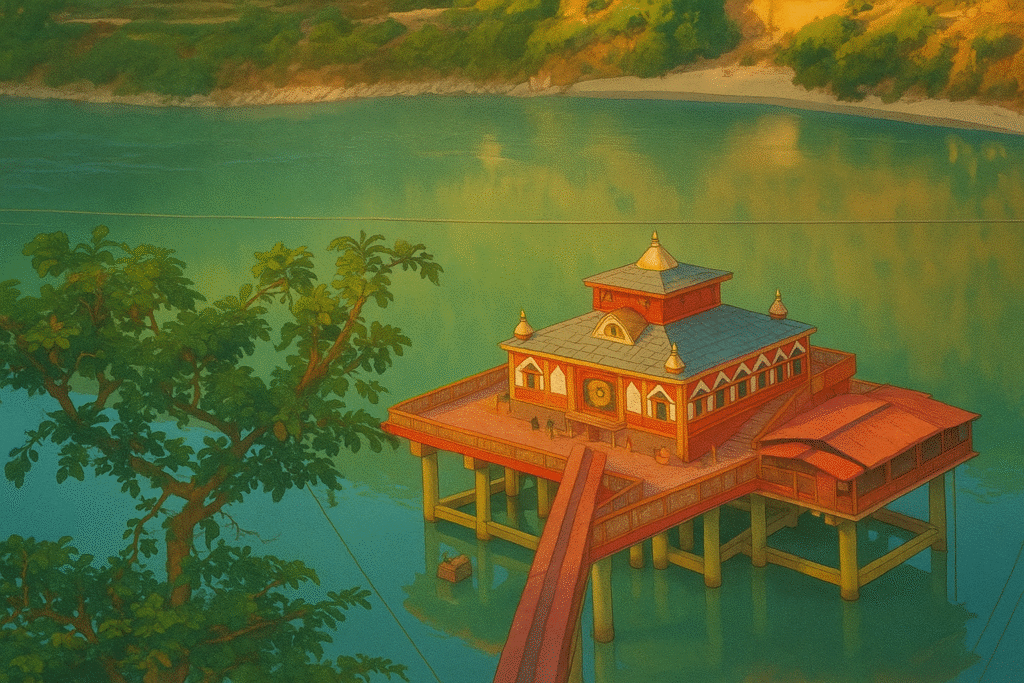
Planning the Trek from Delhi: Monsoon Logistics
Monsoon treks require more than just excitement—they demand preparation. If you’re planning the Tungnath Chandrashila Trek from Delhi, there are a few things you need to keep in mind to ensure your journey is both smooth and safe.
Best Route for Chopta Tungnath Trek from Delhi
The most popular and scenic route for the Chopta Tungnath Trek from Delhi is via Rishikesh – Devprayag – Rudraprayag – Ukhimath – Chopta. The distance is roughly 450–480 km and takes around 12–14 hours by road, depending on weather and traffic conditions. During monsoon, landslides are a real risk, especially between Rudraprayag and Chopta, so start your journey early in the morning and check Uttarakhand weather advisories before leaving.
You can drive your own vehicle, but for monsoon travel, I recommend hiring a cab with a hill-experienced driver or booking a group package. Many Chopta tour packages from Delhi now offer monsoon-special itineraries with safer travel options and flexible dates in case of road closures.
What to Pack for Tungnath Chandrashila Trek from Delhi
Monsoon trekking demands smart packing. For the Tungnath Chandrashila Trek from Delhi, here’s what saved us:
- Rain gear: A waterproof poncho or rain jacket with a hood is essential. Umbrellas are not practical on the trek.
- Trekking shoes: Go for shoes with strong grip and ankle support; trails get muddy and slippery.
- Layers: Even in July, it gets chilly at Tungnath and Chandrashila, especially after rain. Carry a light fleece or down jacket.
- Power bank and torch: Power outages are common, so having your own source of light and backup charge is helpful.
- Snacks and hydration: Few stalls are open during monsoon, so carry dry fruits, energy bars, and your own water bottle.

Travel Timing and Local Transport
Start your drive from Delhi by 10PM and try to reach Chopta next day afternoon. Local transport is limited in monsoon months, and shared jeeps or buses may not always be available on time. Booking the trek through a reliable tour operator ensures you’re not left stranded due to weather-related delays.
If you’re planning the Chopta Tungnath Trek from Delhi in the rainy season, logistics matter just as much as enthusiasm. With the right plan, the journey becomes an adventure in itself.
Best Stay Options During Monsoon: Cottages & Camps
Accommodation in Chopta is simple and rustic—don’t expect star-rated resorts here, especially during the monsoon. But what you will find is charm, solitude, and views that feel like they’ve been pulled straight from a dream. Choosing between a cozy cottage and a rain-soaked alpine camp can shape your entire monsoon experience.
Cottages: Comfort with Character
If you ask me, cottages are the better pick during the rainy season. Why? One word—shelter. Monsoon in Chopta can get wild, with sudden cloudbursts and bone-chilling winds at night. Most cottages are built with solid stone or wood, offering more protection and warmth than tents. The one I stayed at had a tin roof that echoed with raindrops at night—it was oddly soothing—and offered a dry, heated room with thick blankets and a hot cup of chai when I needed it most.
Some cottages are even part of Chopta tour package offerings, which means meals, bonfire setups (when the weather allows), and guides are included. You’ll also find options with attached washrooms, basic electricity, and solar-powered backup systems—small comforts that matter a lot when you’re wet, cold, and tired from trekking.
Camps: Adventurous, But Weather-Dependent
Camps have their own magic too—imagine waking up to mist swirling just outside your tent flap—but they’re better suited for dry seasons. During monsoon, tents can get damp inside, and muddy paths can make it harder to walk around the campsite. Most tour operators avoid full-fledged camping during July–August or offer hybrid stays where you camp one night and move into a cottage the next.
If you’re booking a Chopta tour package, ask for flexibility in stay options. Good operators will shift your accommodation to a safer and drier alternative if the weather turns extreme.
In short: If you’re a comfort-loving traveler who doesn’t want to compromise sleep and warmth, go for a cottage. If you don’t mind a bit of damp adventure, camping could still be an option—with the right gear.
Bonfires, Group Activities, and Rainy Season Charm
One of the most underrated joys of traveling to Chopta during monsoon is the cozy, close-knit vibe that naturally forms among trekkers and travelers. When the rain pours and the clouds roll in, there’s an unspoken understanding among everyone—you’re all in this together, and somehow, that turns strangers into friends.
After a long day of trekking through misty trails and rain-drenched meadows, there’s nothing quite like returning to your stay, shedding your wet gear, and huddling around a warm bonfire. While full-fledged bonfires can be hit-or-miss depending on the rain, many cottages and eco-stays have covered fire setups or indoor common spaces with heaters. The smell of wood smoke mixed with fresh mountain air, the crackling fire, and shared tales of slips and summit struggles—it’s all part of the magic.
If you’re doing the Chopta Chandrashila trek from Delhi as part of a group package, chances are your evenings will be filled with more than just sitting around the fire. During my stay, we had group games, guitar sessions, and even a mini antakshari battle where people from different states joined in. Rain has a way of slowing things down, giving everyone a reason to pause, connect, and just be.
Even simple activities like sipping chai while watching the clouds drift by, or walking to the nearby dhaba during a light drizzle, feel amplified during monsoon. It’s not about constant adventure—it’s about soaking in the little moments.
The rainy season adds a different rhythm to the hills. It quiets the noise, deepens conversations, and brings people together in ways dry weather rarely does. Whether you’re sitting by a fire, sharing local stories, or laughing over slippery trek mishaps, there’s a raw, unfiltered joy to it all.
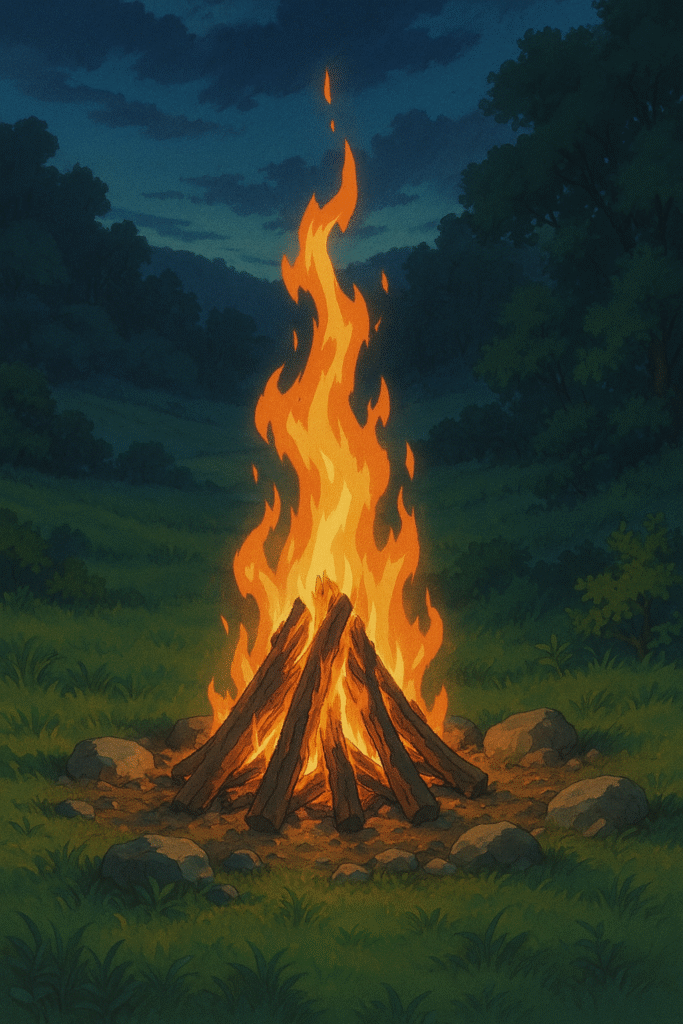
Monsoon Travel Safety Tips & Trekking Advice
Monsoon in the mountains is as unpredictable as it is beautiful. If you’re planning to attempt the Chopta Tungnath Trek or the Chandrashila summit trek during this season, a little extra caution goes a long way. Here’s what I learned (sometimes the hard way) while trekking through the clouds.
Choose the Right Gear
For the Chopta Tungnath Trek, waterproof gear is your best friend. Invest in good-quality trekking shoes with a strong grip. Avoid sneakers or regular sports shoes—they’ll betray you on mossy, wet trails. A lightweight rain poncho or rain jacket, waterproof backpack cover, and quick-dry clothes are essentials.
For the Chandrashila summit trek, trekking poles are a game-changer. They provide stability on loose rocks and help conserve energy during steep climbs. Don’t forget a headlamp or torch in case fog sets in early or you get delayed.
Start Early, Always
Weather during the monsoon is most stable in the morning. Begin your Chopta Tungnath Trek by 6 or 7 AM at the latest. The trails get more slippery and visibility drops as the day progresses, especially in dense fog.
If you’re planning to push for the Chandrashila summit trek, try to start the final ascent shortly after reaching Tungnath. This gives you the best chance to summit before clouds completely take over or rain starts again.
Respect the Terrain
Don’t underestimate short distances. Monsoon changes the game—what seems like a 3 km hike can take double the time. Watch your step on stone-paved sections of the Chopta Tungnath Trek, and avoid venturing too close to ledges on the Chandrashila summit trek if fog is thick.
Stay Informed
There’s little to no mobile signal once you leave Ukhimath. Inform someone of your itinerary before starting the trek. Also, keep an eye on local weather updates or alerts issued by the Uttarakhand authorities.
Go with a Guide or Group
If it’s your first time doing the Chopta Tungnath Trek or Chandrashila summit trek, consider booking a guide or a package. Locals know the terrain, weather patterns, and safe alternate routes in case of a sudden landslide or washout.
With the right preparation, these treks become unforgettable—not just because of the views, but because you conquered them when nature was at its wildest.
Final Verdict: Is Chopta in Monsoon Truly Worth It?
So, after slipping through muddy trails, watching clouds wrap around ancient temples, and sipping chai under tin roofs—was it worth visiting Chopta during the monsoon? My answer is a loud and heartfelt yes. But it’s not for everyone.
Monsoon transforms the entire region into a dreamscape. The meadows are greener, the forests denser, and the whole place feels like it’s breathing. There’s something poetic about walking the Chandrashila Trek in light rain, where the mountains reveal themselves one peek at a time, like they’re shy. Every moment feels alive, unpredictable, and deeply personal.
But let’s be real—there are challenges. Roads are tricky. The weather can force changes in your itinerary. The Chandrashila Trek especially can be fogged out or rained out if you don’t catch the right window. And yet, it’s that very unpredictability that makes the journey memorable. You earn your views. You learn patience. You connect deeper—with the land, with yourself, and with your fellow travelers.
This is where Chopta tour packages from TourMyHoliday come in handy. Going solo in monsoon can be risky if you’re not used to mountain travel. A reliable package from TourMyHoliday ensures you have safe transportation, cozy cottage stays, and experienced local guides who understand the terrain and shifting monsoon moods. Their monsoon itineraries offer flexibility, which is crucial when nature decides to take the lead.
If you’re someone who thrives on comfort, fixed schedules, or picture-perfect weather, you might find the rainy season frustrating. But if you’re seeking a raw, real mountain experience—one that comes with mood swings and misty rewards—Chopta in monsoon might just become your favorite trip.
So here’s my take: the monsoon isn’t a limitation—it’s an invitation. To slow down. To embrace the unknown. And to experience the Chandrashila summit Trek and Chopta’s beauty in a way that few others do.
If that excites you more than it scares you, then don’t wait. Pack your raincoat, lace up your boots, and book your Chopta tour package with TourMyHoliday. This could be the monsoon escape you’ll talk about for years.
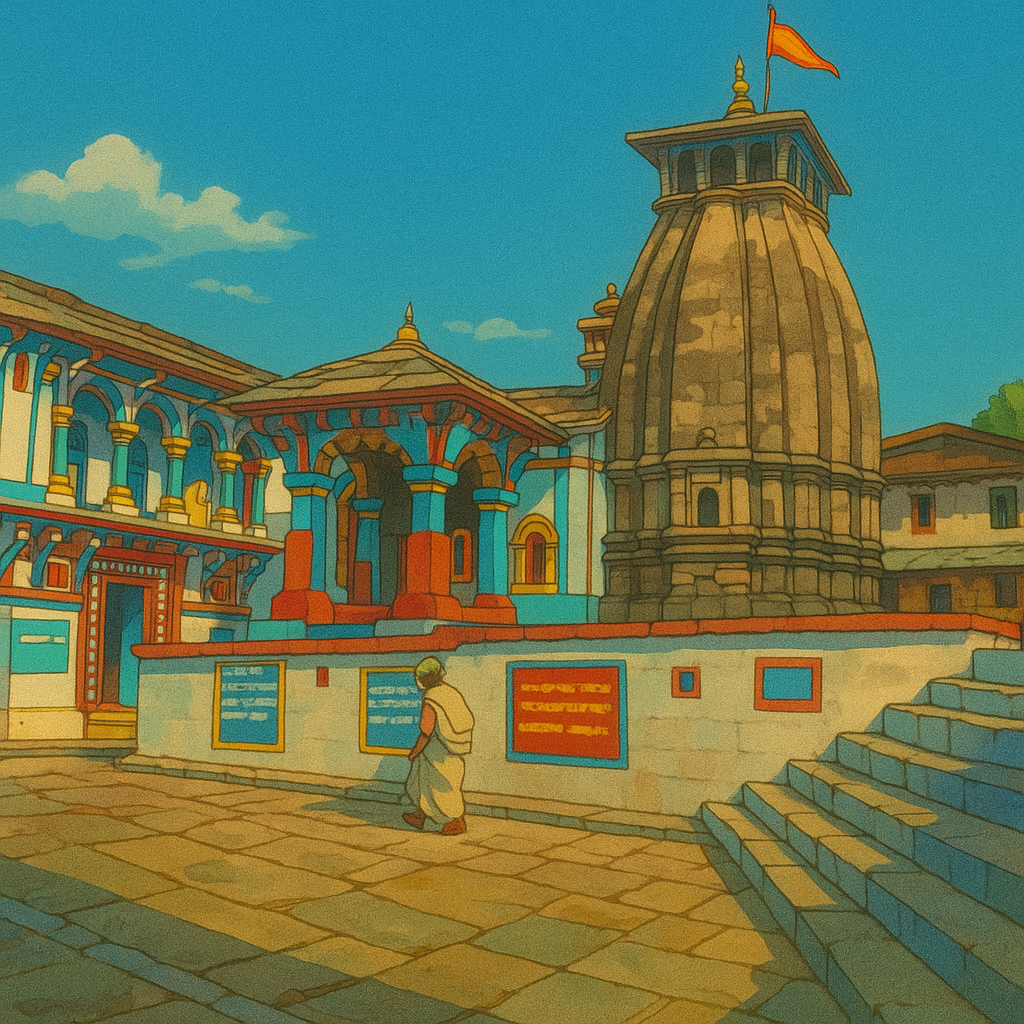
Frequently Asked Questions
- Is it safe to travel to Chopta during the rainy season?
Yes, with proper gear and updated weather info. Packages often include contingency plans and local support. - What are the highlights of the Chopta tour package in monsoon?
Mist-covered forests, lush valleys, spiritual treks to Tungnath Temple, and cloud-kissed views from Chandrashila summit. - Is the Chopta Tungnath Trek accessible during heavy rains?
It’s open but mildly challenging. Packages account for weather delays and guide support for the trek. - Can I customize my Chopta tour package for monsoon?
Definitely! Many providers offer flexibility for trek difficulty, stay preferences (camps vs cottages), and nearby add-ons. - Are bonfires and group activities included despite the rain?
Yes, when conditions permit. Some packages adapt these for indoor cozy setups with local stories and music. - How many days are ideal for a monsoon Chopta tour package?
3–4 days work well, allowing time for acclimatization, trekking, and enjoying the scenic atmosphere. - What should I pack for a Chopta tour package during rains?
Waterproof trekking shoes, poncho, quick-dry clothes, torch, power bank, and basic medical kit. - Do packages offer travel from Delhi to Chopta during monsoon?
Yes! Many Chopta tour packages start from Delhi with transportation by tempo traveler or SUV options. - Can beginners join the Chopta Chandrashila trek in monsoon?
With guided support included in the package, even first-time trekkers can enjoy it—though caution is advised. - Are accommodations safe and comfortable in the rainy season?
Tour packages usually include pre-vetted camps or cottages that are monsoon-proof and cozy. - Is mobile connectivity available during monsoon Chopta treks?
It’s spotty. Some tour packages include walkie-talkies or local sim cards for emergencies. - Do Chopta tour packages include meals suited for monsoon weather?
Yes. Expect warm, simple vegetarian meals ideal for cold, wet conditions—often with tea and soups. - What is the refund policy for Chopta tour packages in case of rain disruption?
Most packages outline flexible cancellation or date shifts—confirm with provider before booking. - Why choose a Chopta tour package instead of self-planning during monsoon?
Packages simplify logistics, weather unpredictability, and local navigation—great for hassle-free adventure.

